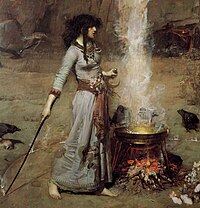
| Part of a series on |
| Witchcraft |
|---|
 |
Cunning folk, also known as folk healers or wise folk, were practitioners of folk medicine, helpful folk magic and divination in Europe from the Middle Ages until the 20th century. Their practices were known as the cunning craft. Their services also included thwarting witchcraft. Although some cunning folk were denounced as witches themselves, they made up a minority of those accused,[1] and the common people generally made a distinction between the two. The name 'cunning folk' originally referred to folk-healers and magic-workers in Britain, but the name is now applied as an umbrella term for similar people in other parts of Europe.[2][3]
- ^ Hutton, Ronald (2017). The Witch: A History of Fear, from Ancient Times to the Present. Yale University Press. pp. 24–25.
- ^ Cite error: The named reference
Davies 2003. p. 163was invoked but never defined (see the help page). - ^ De Blécourt 1994.